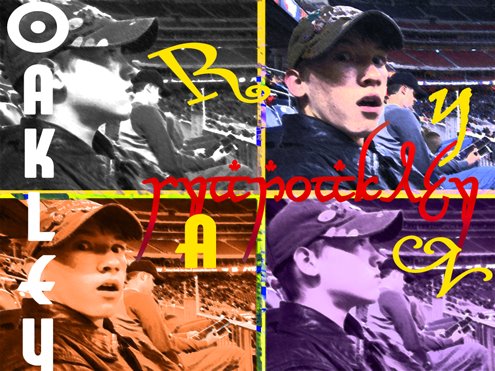The Effects of Media
EFFECTS OF MEDIA
Media education is an excellent way to develop courses and programs for children and their learning environments as television, video games, and the internet are already customary in their daily lives (Baltruschat, 2004).
The great phenomenon of media has for long been presented as a source of entertainment but not necessarily for education. The exposure to media is unavoidable and increasingly integrates society in a number of ways including the world of academics. One major aspect and concern, however, are the positive and negative effects media has on an individual at both early and higher levels of development.
Very few studies have investigated the demographical issues of media effects on children younger then six, such as Anand & Krosnick’s 2005 study in predicting the amount of media used among infants, toddlers, and preschoolers. Whereas other studies have investigated the effects on high school and college students in both extracurricular and crosscurricular situations. Whether it be for pure enjoyment of the vast amounts and forms of communications or a deeper approach to understanding the world that surounds, researchers are hard at work discovering what role media plays on individuals and societies alike, including how its effects can be channeled to benefit both in immense ways.
Media in Early Development
For centuries books and written forms of communication have been a primary method for sharing and exploring new ideas. Although the written word may never die, the way it is presented will always continue to progress and change. A study in the Netherlands explores the possibilities of text in electronic form and investigates the use of electronic books and how children understand story and character development in both traditional and electronic forms (De Jong & Bus, 2004). As traditional bound books featured physical turning pages, the electronic versions featured animated illustrations and interactivity. Both methods were equally understood by said children yet some of the responses and effects varied.
In De Jong and Bus’ (2004) study, kindergarten students were observed using interactive books and computer software with features that allowed readers to involve themselves with the stories by selectable screens and objects that would lead to strings of animations and interactivity. The major concern was whether or not the interactivity was too distracting for children in early development to fully comprehend the stories. Most media require a passive viewing where little thinking and processing are involved. This is where most of the concern comes from concerning the extensive use of new media in education. Though the ability for children to read on their own still may always require the close guidance of parents, this study provides results that suggest that is such the case. It is determined, then, that the close involvement of children and adults reading together may remain crucial at certain levels of development.
The concluding research found that reading several times stimulates children to be more vigilant toward details while at the same time expanding their vocabularies. For further research, scientists could also consider what factors influence developers of these interactive stories and reveal how they are trying to create a better learning experience for young children (De Jong & Bus 2004).
One other aspect from the electronic books is that children were able to interact with the stories creating a more hands on experience. Children with traditional bound books were left with standard illustrations, yet both groups showed the same amount of interest and comprehension of the stories. A final factor is the ability of the children to recreate the stories and to visualize them with only standard text as their imaginations develop (De Jong & Bus, 2004).
By making media a part of education and curriculum, a large involvement of students of all ages and stages of learning prove to be a much more enjoyable experience. Interactive media has been a fast growing trend in society and schools showing impressive results while having hands-on study and homework assignments has increased student participation and readiness in real world environments. Furthermore, the production process has allowed students to engage media education to learn more about mass media and the influence it has on themselves and their society (Baltruschat, 2004).
Hobbs and Frost’s 2003 study researches the interpretation of media used not only in educational environments but also those on television and advertisements. Currently, some schools are developing curriculum in media literacy allowing students an opportunity to better interpret the process messages within each program they observe.
Two high school groups in one study were assigned to undergo a series of exercises where they needed to identify certain elements in written, audible, and visual forms. One group was given no specific instructions and the other a new experimental curriculum (Hobbs & Frost, 2003). Both groups showed varied results showing a contrast between what students needed to know about media and what they already knew.
For further research, De Castell and Jenson’s 2005 observations of a new and quickly emerging educational field--videogames--could be of great use into understanding the future of education. The separation of work and play appears to be of the greatest concern among participants. Once they discover they are having to work to achieve goals, the process no longer seems voluntary or enjoyable. Despite this, video game developers are consistently coming up with new ways to stimulate the mind with games, puzzles, and simulations that keep an active player living and learning together at once.
What could be even more exciting is the use of virtual reality in some cases mostly
including some colleges as courses in theatre explore the use of computer generated sets to teach scenography to emerging students in the new generation of visual communications (Kuksa, 2009).
Although media and media education shows great promise in immense advancement for individuals at several different levels of learning, there are some negative effects to consider as the influence of media is just as strong in producing adolescence and violence.Media Violence, Adolescents, and Influence
Adolescence and violence among teenagers has gone far beyond the hallways of schools and even beyond teenagers as the internet evolves into a new playground of violent behavior. Internet bullies have become quite common around the World Wide Web and is a serious issue; however, there are many researchers developing ways to try and ease the social status of these types of individuals. In Cileziz’s 2009 study, the implication of media use in internet cafes as social phenomenon may be able to reform the way many educate themselves and socialize in controlled and understanding environments. Although computers and internet technologies may be a direct link to adolescent behavior, development of a better sense of how to make the social experience more enjoyable and safer for all participants has much needed potential in educational and political arenas.
Legitimizing education in video games has been a tough case but video games that are designed to educate proper behavior and tactics for successful living could, in fact, also be promoting violent behavior--especially coming from the contemporary and most popular first-person shooters. Although the video game industry has been strictly for entertainment purposes, many are trying to develop games to stimulate positive mental development and social skills. It is arguable that it may not necessarily be that digital games are to blame for the increase in violent behavior rather it may be a lack of observing decaying ethics in the new digital age (De Castell & Jenson,2005).
Anderson et al. (2003) argues that violence in mainstream television and video games may also still be a primary factor in leading society to adolescent and aggressive behavior. In this study the relationship youth have between their intake of violent mediums of entertainment (especially videogames) and their behavior in the real world are examined closely. Though violence in media is indeed a problem as evidence clearly shows there were some limitations concerning a call of action necessary to reduce the effects of violence as the result of overexposure.
Furthermore, media violence could also explain a cause for racial bias and prejudice as found in a two-study experiment focusing on the relationship of televised demonstrations of violence and race. Whether what is shown through fictional broadcast is affecting the viewers’ prejudice in real-world situations the results between both studies remain consistent to some degree showing that the race of any televised character has note-worthy effects on the emotions and mindset toward non-white citizens outside the settings of broadcast television. (Mastro, Lapinski, Kpacz, & Behm-Morawitz, 2009)
This may conclude that a better method toward properly interpreting media is at hand as what is crucial in academic literacy and integrity could also be used towards informing a culture of the critical thinking skills necessary to separate fiction from real life scenarios.Media Literacy
Technological skills and the ability to properly interpret media is shaping most society where a job, an education, or even citizenship will rely on an individual’s ability to use and understand new forms of communication. The electronic age continues to pursue forward: the way communication is developed, coded, and decoded is constantly changing. However, some communities and individuals may be left behind or even mislead if not taken carefully through the technological advancement.
Information and Communication Technologies (ICTs) is at the heart of a new revolution in the way people think, what they value, and how they behave. As for the technologically declined or illiterate, they could very well be left behind in the stone-age of written forms of communication being denied jobs, education, and even legitimized citizenship all because of a lack of computer and technological ability (Valentine & Holloway 2002).
In a study done by Valentine & Holloway (2002), they focused more on the future, the children of technology or “Cyber kids.” The study included extensive interviews with professionals and closely examined the relationships under development in both real-world and virtual-world environments. While investigating the acts and behaviors of children, the main topic of discussion tends to lean to what future society holds and seems fruitful; however, it would be wise to include what a common man can do to survive in the new virtual and high-speed society.
Because younger generations represent a very different and new emerging culture, some research is being done to analyze how parents feel about their children’s exposure to media. By using third-party perspective of parents and other children, researchers avoid what is described as self-enhancement. This is to say that interviews and studies based on performance that are left to an individual will almost always end up way above average. Statistically speaking, this is impossible; wherefore, scientists took a new approach into discovering what true effects media has on children both positive and negative. More specifically, studies are looking into how media influences a child’s (un)disability for materialism and how this effects their behavior. (Meirick, Sims, Gilchrist, & Croucher, 2009).
Another study looks closely at media bias and its presence in news coverage concerning the Iraqi war. More specifically, the study examines the relationship between two majorly competing networks, CBS and Fox, and their audiences. The term “persuasion theory” is mentioned thoroughly explaining how these tactical forms of communication can mislead well-educated audiences just as well as those with no education at all. Research reveals that a critical eye over news media needed by its viewers as its role in informing the populace sways from one political party to the other (Johansen & Joslyn 2008).
As mentioned earlier, the effects of media and media literacy are taken into consideration in Hobbs & Frosts 2003 study using data gathered from two separate eleventh-grade English student groups One group was assigned to critically examine and interpret print, audio, and visual media while the other was given no specific instructions or guidelines. The objective was to see the advantages and disadvantages of presenting students with a curriculum that guided their understanding towards properly identifying media aspects such as targeted audience and process messaging. There was a great contrast between students who were educated on media literacy and those who were not. Although one can assume the great amount of exposure to media in the information age would constitute a natural understating on the presented material, this study goes to length revealing a necessity to educate students to properly engage and comprehend the literacy behind all mediums of communication.
A final example of media dependency and over reliance is that in smaller community colleges, the aid to new students is lacking as many factors revealed in Deil-Amen and Rosenbaum’s 2003 study showing that students are not receiving the social know-how they need to be successful. Many students do not receive one-on-one counseling concerning their major are left with only current students for aid in choosing appropriate courses. A suggested means to counteract the lack of social skills is the implication of computer aided technologies; however, it may not be effective to learn social skills from a machine. Through better interaction with the people behind the courses rather then simply improving new student’s awareness of computer aided technologies could also be a sign of poor media literacy and understanding of its limitations.Summary
Society will forever use words to express themselves--the means of how one does this is in a constant flux of change from the way one says something to how he says it. The new extremes of what technology can communicate throughout the world is a demonstration of incredible power, power that must be taken into careful consideration and responsibility. Researches will continue to observe the intriguing activity of media education and development as both positive and negative aspects will be taken into an account. Although both media consumer and creator influence remains somewhat ambiguous as each individual value varies from person to person, there still remains a format of proper interpretation and representation of all that surounds. Any misuses or misleading material should be perfectly understood as such as each individual has a right to achieve an amble amount of skills to correctly understand the messages being portrayed in all forms of media. As media is used to teach and learn new experiences, the information age will also require courses in media literacy as studies have shown that little is understood about mediocracy unless properly enforced. It has also been observed that even the youngest of citizens can be majorly influenced by media up until they attend universities in higher education. Even then, individuals and society alike could still be subject to misinformation or harmful effects due to negative influences improperly interpreted as appropriate behavior. As art influences life, so does life influence art; as communications changes so does society, and as society changes, so does communications. It is up to educational boards, business, news networks, and individuals alike to stay on top of the changing times to ensure both current and future societies will advance and prosper in this roaring sea of digital information.
Anderson, C.A., Berkowitz, L., Donnerstein, E., Husesmann, L.R., Johnson, J.D., Linz, D., Malamuth, N.M., & Wartella, E. (2003, Dec). The influence of media violence on youth. [Electronic version]. Psychological Science in the Public Interest, 4, (3), 81-110.
Baltruschat, D. (2004). The ABCs of media education: A hands-on-approach. [Electronic version]. Feliciter, 50, 190-192.
Cilesiz, S. (2009, Mar). Educational computer use in leisure contests: A phenomenological study of adolescents’ experiences at internet cafes. [Electronic version]. American Educational Research Journal, 46, 232-274
Deil-Amen, R., & Rosenbaum, J. E., (2003, Mar). The social prerequisites of success: Can college structure reduce the need for social know-how? [Electronic Version]. Annals of the American Academy of Political and Social Science, Vol. 586, 120-143
De Castell, S., & Jenson J. (2005). Videogames and digital gameplay - The new field of educational game studies. [Electronic version]. Orbit, 35 (2), 17.
De Jong, M.T., & Bus, A.G., (2004, Oct-Dec). The efficacy of electronic books in fostering kindergarten children’s emergent story understanding. [Electronic version]. Reading Research Quarterly, 39, 378-393.
Duran, R.L., Yousman, B., Walsh, K.M., Longshore, M.A. (2008, Feb). Holistic media education: An assessment of the effectiveness of a college course in media literacy. [Electronic version]. Communication Quarterly, 56, 49-68.
Hobbs, R., & Frost, R. (Jul.-Sep., 2003) Measuring the acquisition of media-literacy skills. [Electronic version]. Reading Research Quarterly. 38, 330-355.
Johansen, M. & Joslyn, M. (2008, Autumn). Political persuasion during times of crisis: The effects of education and news media on citizens’ factual information about iraq. [Electronic version]. Journalism & Mass Communication Quarterly, 85 (3), 591-608.
Kuksa, I., (2009). Virtual reality in theatre education and design practice -- new developments and applications. [Electronic version]. Art, Design & Communication in Higher Education, 7, 73-89.
Lou, Y., Abrami, P.C., & d’Apollonia, S. (2001, Autumn). Small group and individual learning with technology: A meta-analysis. [Electronic version]. Review of Educational Research, 71, (3), 449-521.
Mastro, D., Lapinski, M.K., Kpacz, M.A., & Behm-Morawitz, E. (2009-Oct.). The influence of exposure to depictions of race and crime in TV news on viewer's social judgments. [Electronic version]. Journal of Broadcasting & Electronic Media, 53 (4), 615-635.
Meirick, P.C., Sims, J.D., Gilchrist, E.S., Croucher, S.M. (2009, Apr-Jun). All the children are above average: Parents’ perceptions of education and materialism as media effects on their own and other children. [Electronic version]. Mass Communication & Society, 12, 217-237.
Valentine, G., & Holloway, S.L. (2002, Jun). Cyberkids? Exploring children’s identities and social networks in on-line and offline worlds. [Electronic version]. Annals of the Association of American Geographers, 92 , 302-319.
"My heart is inditing a good matter: I speak of the things which I have made touching the king: my tongue is the pen of a ready writer."












